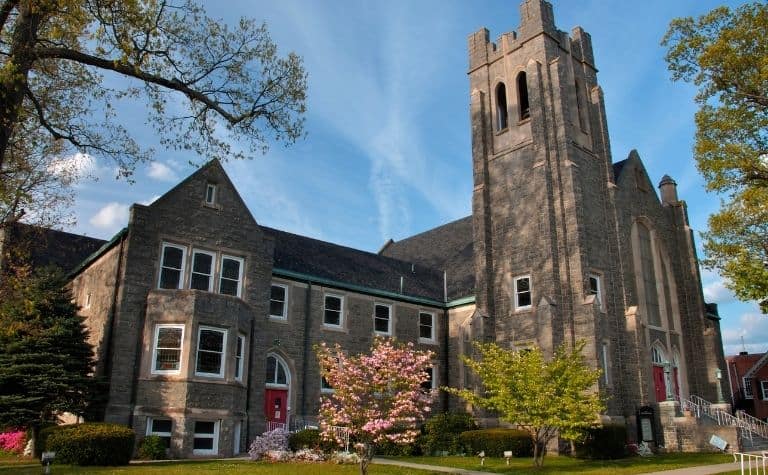The Presbyterian and Methodist traditions have been two of the most prominent branches of Protestant Christianity over the last 500 years. Each has a strong tradition of biblical preaching, administering the sacraments, and investing in global mission work. Yet many people wonder about the difference between the denominations.
Presbyterianism originated in 16th-century France through the influence and ministry of John Calvin. It subscribes to Calvinist and Reformed theology. Methodism originated in 18th-century England through the influence and ministry of John Wesley. It subscribes to Arminian theology. Both are Protestant.
What are the essential differences in what Presbyterians and Methodists believe and practice? What doctrines do they agree about, and where do they differ? What challenges is each tradition facing in the 21st century? What are the largest denominations in each tradition in the 21st century? Keep reading to learn more.
Also, see Presbyterian vs Roman Catholic: What’s the Difference? to learn more.

Presbyterianism and Methodism Compared
The Presbyterian and Methodist traditions have a lot in common. Historically, they both hold to fundamental Christian convictions like belief in the Trinity, the deity of Jesus Christ, inspiration and authority of Scripture, and the Second Coming. (Also see Presbyterianism vs. Pentecostalism: What’s the Difference?)
Presbyterians and Methodists both reject Catholic doctrines such as the authority of the papacy, communing with saints who are no longer living on Earth, including Mary, the mother of Jesus, and transubstantiation, which teaches that the bread and cup at communion literally turn into the body and blood of Christ.
| OVERVIEW | Presbyterian | Methodist |
|---|---|---|
| Origin and roots | 16th-century France and Scotland; the Protestant Reformation in Germany | 18th-century Oxford, England; the Anglican tradition (i.e., the Church of England) |
| Early influencers | John Calvin in France (1509-1564) and John Knox in Scotland (1514-1572) | Brothers John Wesley (1703-1791) and Charles Wesley (1707-1788) in England |
| Meaning of name | From the New Testament Greek word “presbyteros,” meaning elder, in the broader sense, refers to an elder-led form of church government. | From the English word “method,” the name refers to what people called the Wesley brothers and other like-minded believers who maintained a strict regiment of spiritual disciplines. |
| Known for | Calvinist/ Reformed theology, including predestination; the Presbyterian form of church government. | Ministering to the poor and suffering, the Holiness Movement within 19th-century Methodism sparked the Pentecostal movement in the 21st century. |
Do Presbyterians and Methodists ever minister together? Yes. Today, many examples exist of Presbyterian and Methodist churches working together for social causes like feeding the hungry.
Famously, John Wesley and Calvinist evangelist George Whitefield (1714-1770) became close friends at Oxford and did ministry together, including in the United States, even though they had significant theological differences.
“I want the whole Christ for my Savior, the whole Bible for my book, the whole Church for my fellowship, and the whole world for my mission field.” ~ John Wesley

Presbyterianism and Methodism Beliefs and Practices
Presbyterian and Methodist denominations and churches have experienced division over social issues in recent years. Church leaders and members wrestle over whether or not to ordain women and to fully accept same-sex couples and those who identify as transgender. (Also see Presbyterian vs. Anglican: What’s the Difference?)
Some denominations have left individual congregations to decide matters on their own, resulting in historic attendance declines. Many liberal churches in each tradition no longer subscribe to the beliefs listed on the chart below, yet they remain the historic convictions of the denominations.
| BELIEFS | Presbyterian | Methodist |
|---|---|---|
| Authority | Scripture is authoritative over tradition | Scripture is authoratative over tradition |
| Christ | Jesus is God, the eternal 2nd person of the Trinity | Jesus is God, the eternal 2nd person of the Trinity |
| Sin | Affirm original sin and total depravity (see below) | Affirm original sin but not total depravity |
| Salvation | Salvation is by justification by grace alone, through faith alone in Christ alone | same |
| Belief system | Calvinism | Arminianism |
| Atonement | Limited; Christ died for the elect | Unlimited; Christ died for all people |
| Theological emphases | God’s sovereignty, providence, and glory | Sanctification alongside justification, freedom of the will |
| Sanctification | Is perfected at death | Some believe it can be perfected before death |
| Baptism | Baptism is a sacrament of the New Testament, ordained by Jesus Christ, not only for the solemn admission of the party baptized into the visible Church; but also to be unto him a sign and seal of the covenant of grace, of his ingrafting into Christ, of regeneration, of remission of sins, and of his giving up unto God through Jesus Christ, to walk in the newness of life. Which sacrament is, by Christ’s own appointment, to be continued in His Church until the end of the world. (Westminster Confession, Ch. XXVIII) | To many Methodists, infant baptism is an act of “prevenient grace,” embedding a desire to seek God and turn from sin |
| Historic internal disagreements | Example: double predestination has been a divisive issue in some Presbyterian churches | Example: revivalism has been a divisive issue in some Methodist denominations and churches |
| Modern internal disputes | “Mainline” vs. “evangelical” or “conservativism vs. liberalism” on topics like the authority of the Bible, which has implications for issues like the ordination of women, same-sex marriage, gender identity, and more | same |
What is “original sin”? The doctrine of original sin states that all people are born in a condition of guilt and are destined to experience eternal death unless there is divine intervention.
It also states that everyone’s sinful nature inclines them to sin and evil. In Methodist theology, God-given prevenient grace overcomes original sin when it’s not resisted. (Also see Presbyterian vs. Baptist: What’s the Difference?)
What is “total depravity”? Total depravity builds on the doctrine of original sin. It holds that every aspect (“total”) of a person is permeated with sin (“depravity”), i.e., their mind, emotions, will, and much more.
A person’s free will can affect a person’s fallen state. Only God’s unearned mercy and grace (though not “prevenient”) that implants in a person’s mind and heart the desire to repent from sin and trust in Christ’s death and resurrection can overcome their totally depraved nature.
List of Presbyterian and Reformed Denominations
The word “Reformed” in certain uses can refer broadly to non-Catholic, non-Eastern Orthodox Christians when the context is the “Protestant Reformation.”
Within Protestantism, “Reformed” is often used as a broad synonym for Presbyterian (e.g., “Reformed theology”) and occasionally for churches that have many Calvinist convictions (e.g., “Reformed Baptist). (Also see What Bible Translation Do Presbyterians Use?)
Historically, “Presbyterian” churches that subscribe to Calvinist theology arose in France and Scotland, while “Reformed” churches that are also Calvinist came out of the Reformation movement in Switzerland.
| Name | Reported Membership |
|---|---|
| Christian Reformed Church in North America | 237,000 |
| Cumberland Presbyterian Church | 71,000 |
| ECO: A Covenant Order of Evangelical Presbyterians | 100,000 |
| Evangelical Presbyterian Church | 150,000 |
| Korean American Presbyterian Church | 55,000 |
| National Association of Congregational Churches | 63,300 |
| Presbyterian Church in America | 370,000 |
| Presbyterian Church (USA) | 1.7 million |
| Reformed Church in America | 246,000 |
| United Church of Christ | 914,000 |
Also see Presbyterian Church USA vs. Presbyterian Church in America: What’s the Difference?
What is the United Church of Christ? The UCC has roots in early American history. Still, the present-day organization results from two denominations merging in the mid-20th century: the Congregational Christian Churches and the Evangelical and Reformed Church in the United States. The CCC and ERC were the results of merged congregations as well. In the 21st century, the UCC is considered a global leader in liberal and progressive Christianity.

List of Methodist Denominations
| Name | Reported Membership |
|---|---|
| African Methodist Episcopal Church | 2.5 million |
| African Methodist Episcopal Zion Church | 301,000 |
| Christian Methodist Episcopal Church | 290,000 |
| Congregational Methodist Church | 15,500 |
| Evangelical Church of North America | 15,000 |
| Evangelical Methodist Church | 7,300 |
| Southern Methodist Church | 6,000 |
| United Methodist Church | 7.6 million |
What are Holiness churches? So-called “Holiness” denominations and churches grew from 18th-century Methodism in England. Theologically, they are Arminian-Wesleyan. When some early Methodist movements focused on evangelism and conversion, the first leaders in Holiness churches emphasized sanctification. The term sanctification describes the process of spiritual growth and maturity into Christ-likeness that the Bible commands.
| Holiness Churches | Reported Membership |
|---|---|
| Free Methodist Church of North America | 110,000 |
| Wesleyan Church | 385,000 |
Other notable Holiness denominations include:
- The Christian and Missionary Alliance (428,000 members)
- Church of God, Anderson, Indiana (233,000 members)
- Church of the Nazarene (905,000 members)
- The Salvation Army (413,000 members)
Please see the related articles below.
References:
[1] Source
[2] Source
[3] Source
Related Articles
Presbyterian and Pentecostal traditions are two of Protestant Christianity's most important and influential branches. While they agree on several essential biblical doctrines, they differ on certain...
The Roman Catholic and Presbyterian branches of the Christian faith trace their origins to Jesus of Nazareth and his apostles, as well as their writings that comprise most of the New Testament. There...
